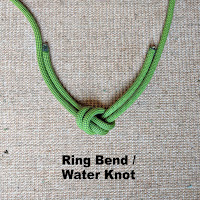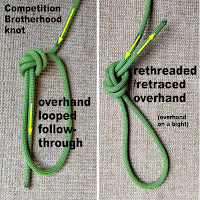==================
 First off, I’m not trying to convince anyone - I’m just putting this out there for anyone interested. Most people are content using whatever knot they’ve always been using. However, since learning of the Competition Knot, I’ve found that it meets my needs most of the time and I've used it off and on for the last 5 years. Some Europeans have been using it for decades. I assume it got it’s name from being used for competition climbing and the likelihood of whipping on it and not impossibly cinching up, though I haven’t confirmed that.
First off, I’m not trying to convince anyone - I’m just putting this out there for anyone interested. Most people are content using whatever knot they’ve always been using. However, since learning of the Competition Knot, I’ve found that it meets my needs most of the time and I've used it off and on for the last 5 years. Some Europeans have been using it for decades. I assume it got it’s name from being used for competition climbing and the likelihood of whipping on it and not impossibly cinching up, though I haven’t confirmed that.
How to tie it:
A simple description - based on how it’s tied is an "overhand looped follow-through” - i.e. the exit strand circles around and enters the same point as the original strand and follows it back around for ‘another lap’.
It has alternately been called the Brotherhood Knot (AMGA manual), It is related to, and has erroneously been identified as a Ring Bend/Water Knot, and Offset Overhand. It’s NOT an overhand retrace or overhand on a bight, in which the exit strand retraces the original strand back through in the opposite direction and both exit the knot on the same side. Like these and many other knots (including the EDK and Overhand on a Bight), it is based on the basic geometry of the Overhand Knot
One of the beauties of the competition knot is that it can only constrict so much in a fall because it is pulling against itself, pulling two of the constricting bights in opposite directions, keeping it somewhat “open” so that it’s easier to untie. Untying it is similar to untying a Figure-8 by flipping two bights to loosen it.
Positives
- uses less rope
- less bulk
- faster to tie (once you know how)
- similar to figure-8 in that no back-up knot is needed (bowline requires a backup knot)
- easy to untie but will not untie by itself if there is no pressure on it
- easy to inspect once you (or your partner) becomes use to it
- It’s helpful as ropes dimeters grow smaller and knots constrict tighter
- especially good when doing laps or working a section of a route because of constant whipping/hanging/rapping which causes knots to constrict more over time
Negatives
- It is little known so it makes people wary. People are afraid of the unknown (sometimes with good reason).
- Not as easy to untie as a Bowline after whipping but better than a Figure-8
- Un-informed partners can’t double check you (but remember our context here is rope soloing :-)
- May not be quite as strong as other tie-in knots, but when is the last time you heard of a rope breaking at the knot from a fall? Your bod will break before the knot does!
- If they see you using it in a gym, they will probably call you out.
Finally, like most knots, it needs to be dressed properly “... tied neatly, with no crossed strands and adequate tail” and tuck extra tail back through belay loop to keep out of the way.
To check knot, you need to do the 2, 2, 2, 2 check with one of the loops strands and the live rope pulling in opposite directions
Note: If you’re geometrically/spatially/or knot challenged, or paranoid re the veracity and appropriateness of this knot...DO NOT USE IT!
YMMV
--------------------------------------------------------------------
Additional background info:
https://www.ukclimbing.com/forums/rock_talk/ring_knot-671974#main
https://www.mountainproject.com/forum/topic/107108289/ring-bend-as-tie-in-knot
https://www.mountainproject.com/forum/topic/111814291/how-do-you-tie-in?page=2
http://www.supertopo.com/climbers-forum/3016274/Tying-in-with-an-Overhand-Follow-Through




